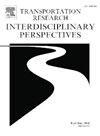Optimization study of dynamic emergency feeder bus paths with the sudden interruption of urban railway traffic
IF 3.9
Q2 TRANSPORTATION
Transportation Research Interdisciplinary Perspectives
Pub Date : 2025-05-01
DOI:10.1016/j.trip.2025.101461
引用次数: 0
Abstract
The rapid expansion of urban rail transit networks has increased their vulnerability to disruptions. When a metro line experiences sudden interruptions, it can severely reduce passenger mobility and degrade the overall transportation system performance. Existing bus feeder programs are often inadequate in responding effectively to dynamic and real-time fluctuations in passenger flow during such disruptions, particularly when combined with complex road traffic conditions. We propose a novel hybrid metaheuristic algorithm for the emergency feeder bus routes with time-window constraints to address this issue. The algorithm combines the Max-Min Ant System (MMAS) and Simulated Annealing (SA) to enhance search performance. A Back Propagation (BP) neural network estimates the emergency demand at each affected station, using historical and structural factors. These estimates are integrated into the hybrid optimization process, improving routing efficiency. The model aims to minimize the total operational time of emergency buses, ensuring timely evacuation. A case study using Beijing Metro validates the model’s effectiveness. Results indicate a 1.7-hour reduction in total passenger travel time and an 84.7% decrease in computation time compared to the Gurobi exact algorithm. These improvements facilitate the identification of optimal feeder paths under varying traffic conditions. The study provides practical guidance for enhancing emergency response strategies in metro systems.
城市轨道交通突发中断情况下动态应急接驳客车路径优化研究
城市轨道交通网络的迅速扩张增加了它们面对中断的脆弱性。当地铁线路突然中断时,会严重降低乘客的流动性,降低整个交通系统的性能。现有的公交接驳计划往往不足以有效应对此类中断期间客流的动态和实时波动,特别是在结合复杂的道路交通状况时。为了解决这一问题,本文提出了一种具有时间窗约束的应急接驳巴士路线混合元启发式算法。该算法结合了最大最小蚂蚁算法(MMAS)和模拟退火算法(SA)来提高搜索性能。反向传播(BP)神经网络利用历史和结构因素估计每个受影响站点的应急需求。这些估计被集成到混合优化过程中,提高了路由效率。该模型旨在最大限度地减少应急客车的总运行时间,确保及时疏散。以北京地铁为例,验证了模型的有效性。结果表明,与Gurobi精确算法相比,总乘客旅行时间减少了1.7小时,计算时间减少了84.7%。这些改进有助于在不同交通条件下确定最佳馈线路径。研究结果为地铁系统应急响应策略的改进提供了实践指导。
本文章由计算机程序翻译,如有差异,请以英文原文为准。
求助全文
约1分钟内获得全文
求助全文
来源期刊

Transportation Research Interdisciplinary Perspectives
Engineering-Automotive Engineering
CiteScore
12.90
自引率
0.00%
发文量
185
审稿时长
22 weeks
 求助内容:
求助内容: 应助结果提醒方式:
应助结果提醒方式:


